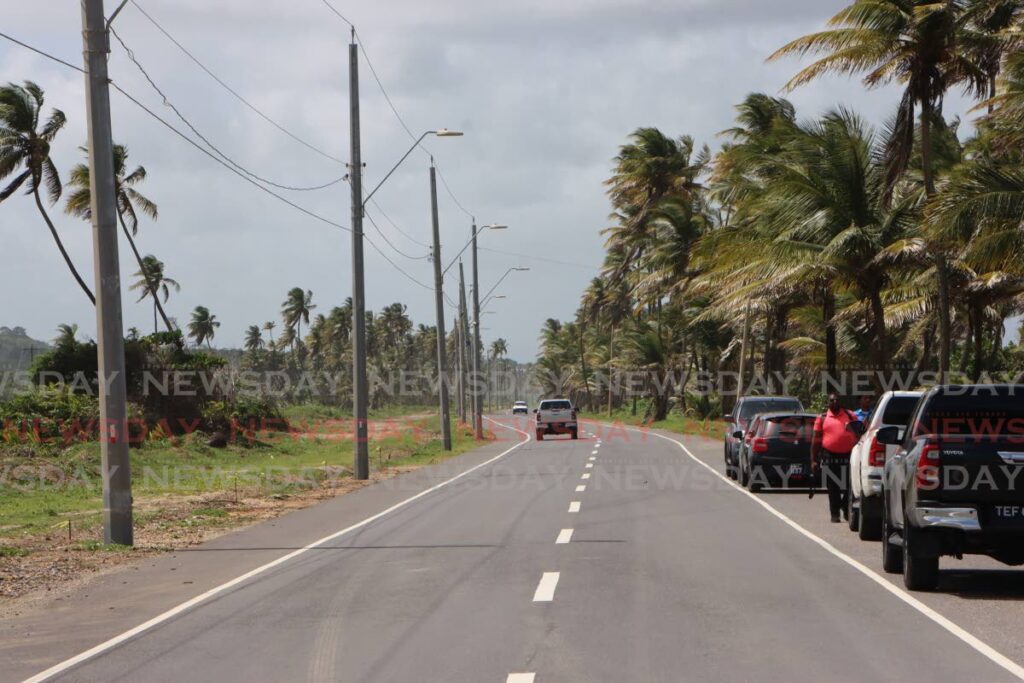Sinanan: Manzanilla Road rebuilt to international standard

MINISTER of Works and Transport Rohan Sinanan said the first phase of the Manzanilla Road has been rebuilt better than its state before it had been damaged by water in November 2022, speaking to reporters on a July 24 tour on the construction. The road was rebuilt to international standards by smoothing, widening and lighting, he said.
The new construction will allow inflows and outflows of water between the sea and the swamp, via nine new culverts, to cater to the natural ecology, including the reality of climate change and environmental rules.
He said the sea and swamp had imposed on the road since the 1960s. "It always washed the Manzanilla Road away. It is about four times it has happened."
Sinanan said with climate change the road's builders had to act a bit differently.
"So we re-engineered the road, raised the road slightly, put in extra drains, extra culvert.
"If you look at the road you will realise it is of a more international standard. It is a single lane, with shoulders."
The road rebuilding would reach Mayaro and then to San Fernando.
Ministry of Works and Transport (MOWT) chief technical officer Mark Cooper said, "We elevated the road to approximately 18 inches or 450 millimetres high above the existing road."
They had installed nine culverts and rehabilitated four, he related.
"The intention is that once the water rises it would go through the culvert and not over top the road and wash away the verges of the road and cause the collapse of the roadway."
The road would not be eroded as easily as before, he said.
"In addition to that the foundation of the road is constructed using a boulder bed. So there is some permeability that would allow water from the swamp to exit on the sea side and there would be somewhat of a balance that would take place between the migration of water between the two, the sea side and the swamp area.

"So essentially the road is somewhat permeable and allows the large volumes of water that come into the swamp to exit on the sea side.
"I think we will be in good stead for the next couple of years."
MOWT's Haydn Richards said at times of red or yellow alerts, the ministry would clear the culverts to facilitate the flow of waters.
Sinanan said Manzanilla was an environmentally-protected area.
"This is a very sensitive area. This is the Nariva Swamp and it is a protected area as well. There are limitations as to how far you could engineer in this area."
He said he was not permitted to raise the road even higher.
"It is designed in such a way to keep the flow of the salt water and the fresh water balanced. We are guided by the EMA (Environmental Management Authority), the IMA (Institute for Marine Affairs), and so on, statutory authorities. This is a very sensitive area. There are limitations as to how far you can go to engineer the area.
"So, we would have pushed it to the limit and we would have been happy to put in more culverts and different types of systems, raise the road, but it is just not allowed by the EMA. We have to work within the boundaries of what the EMA gives us."
Newsday asked if the project would always be a work in progress, he replied, "Exactly. You engineer based on an assumption.
"But if you get much more rainfall than that, as you see happening around the world, the infrastructure will be challenged."
He said in the past, the ministry built bridges to withstand the effects of a storm whose magnitude would be expected to be seen as frequently as one in 25 years, but then moved to withstand a worse magnitude one-in-50 years storm.
"There are countries now with a one-in-100 year storm to build the bridge! That triples the price of the bridge. So you can't just build bridges around the country for a one-in-100 year storm.
"So you normally engineer for a certain volume. But look around the world!" Even developed countries were being flooded out with excess waters.
He said the first phase had five packages, each with different contractors, for some $63 million.
"They all came in within the budget."
He said the ministry was now in the second phase which would reach the Nariva Bridge and consist of five packages, which he expected to go faster than phase one as it included no culverts.
Sinanan said the programme was to upgrade the network of existing roads, until replaced by a series of highways. He said the old Valencia Road had been likewise upgraded, in similar structure to the Claude Noel Highway in Tobago.
Sinanan said, "When the road was washed away, we had an estimated budget of $12 million and it was bandied about we spent $12 million just for the temporary road."
He said the cost had actually been $7 million-plus, and materials from that road had been re-utilised in the current project.
"We are just not wasting the materials especially when we re-mill the roads. We are recycling it and it is giving us a much more durable product."
Asked if the road's smoothness would encourage dangerous speeding, he said speed humps would make things more hazardous. "Every one has a personal responsibility," he said. Recalling a truck just speeding past him, he said, "The 'breeze' nearly take me away."
Sinanan said in the hemisphere, only TT had halved its road fatality rate, a few years ago.

Comments
"Sinanan: Manzanilla Road rebuilt to international standard"